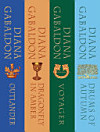Whiteladies
Mrs. Oliphant
જૂન 2022 · DigiCat
ઇ-પુસ્તક
444
પેજ
family_home
પાત્ર
info
reportરેટિંગ અને રિવ્યૂ ચકાસેલા નથી વધુ જાણો
આ ઇ-પુસ્તક વિશે
In "Whiteladies," Mrs. Oliphant masterfully weaves a narrative that explores the nuanced relationships within a fading aristocratic family in 19th-century England. Through her intricate character development and keen social observations, Oliphant illuminates the tension between individual desires and familial duty, set against a richly textured backdrop of English society. The prose is elegant and reflective, employing a tone that resonates with both poignant melancholy and subtle humor, capturing the complexity of her characters' lives amidst swirling social changes of the Victorian era. Mrs. Oliphant, a prolific Scottish novelist and biographer, was known for her insightful portrayals of women's roles and the struggles of the Victorian psyche. Her own experiences as a writer navigating a predominantly male literary world undoubtedly informed her sensitivity to the challenges faced by women like her protagonists. Through "Whiteladies," Oliphant channels her observations of societal expectations and personal fulfillment, making her work a reflection of both her time and her own life experiences. Readers seeking a deep exploration of personal and social themes, rendered with exquisite prose, will find "Whiteladies" a compelling addition to their literary collection. This rich narrative not only serves as a window into a bygone era but also resonates with contemporary issues of identity and societal obligation, making it a timeless read.
લેખક વિશે
Margaret Oliphant, known professionally as Mrs. Oliphant, was a prolific Scottish novelist and historical writer, who typically portrayed domestic life and society in her works. Born on April 4, 1828, in Wallyford, Scotland, she gained considerable recognition in the Victorian era, contributing more than 120 works of fiction and non-fiction over her career. Mrs. Oliphant's literary style often intertwined the themes of gender, class, and the supernatural, allowing her to effectively address the roles and challenges of women in her time through subtle social commentary. 'Whiteladies' is one of her memorable works, showcasing her trademark blend of realism and romanticism, with an acute understanding of interpersonal dynamics and the intricacies of social structures. Mrs. Oliphant's contribution to literature was not just voluminous but also insightful, often exploring the resilience of women in the face of personal tragedies, much like those she herself experienced in her life. Despite the occasional critical denial of depth in her writing, her work resonates due to her nuanced characters and vibrant storytelling. She died on June 25, 1897, but remains a studied figure in the canon of 19th-century literature, not least for her depictions of Victorian society and the female experience within it.
આ ઇ-પુસ્તકને રેટિંગ આપો
તમે શું વિચારો છો અમને જણાવો.
માહિતી વાંચવી
સ્માર્ટફોન અને ટૅબ્લેટ
Android અને iPad/iPhone માટે Google Play Books ઍપ ઇન્સ્ટૉલ કરો. તે તમારા એકાઉન્ટ સાથે ઑટોમૅટિક રીતે સિંક થાય છે અને તમને જ્યાં પણ હો ત્યાં તમને ઑનલાઇન અથવા ઑફલાઇન વાંચવાની મંજૂરી આપે છે.
લૅપટૉપ અને કમ્પ્યુટર
Google Play પર ખરીદેલ ઑડિઓબુકને તમે તમારા કમ્પ્યુટરના વેબ બ્રાઉઝરનો ઉપયોગ કરીને સાંભળી શકો છો.
eReaders અને અન્ય ડિવાઇસ
Kobo ઇ-રીડર જેવા ઇ-ઇંક ડિવાઇસ પર વાંચવા માટે, તમારે ફાઇલને ડાઉનલોડ કરીને તમારા ડિવાઇસ પર ટ્રાન્સફર કરવાની જરૂર પડશે. સપોર્ટેડ ઇ-રીડર પર ફાઇલો ટ્રાન્સ્ફર કરવા માટે સહાયતા કેન્દ્રની વિગતવાર સૂચનાઓ અનુસરો.








